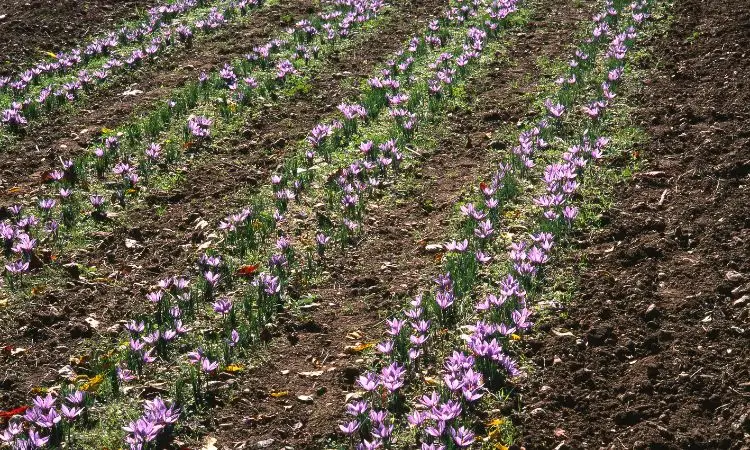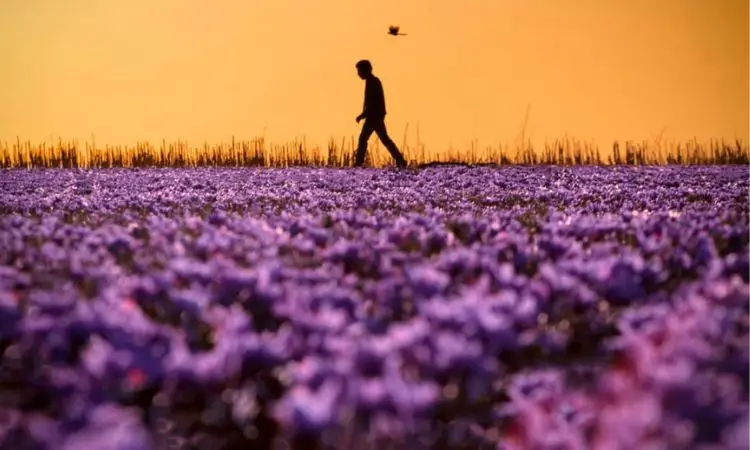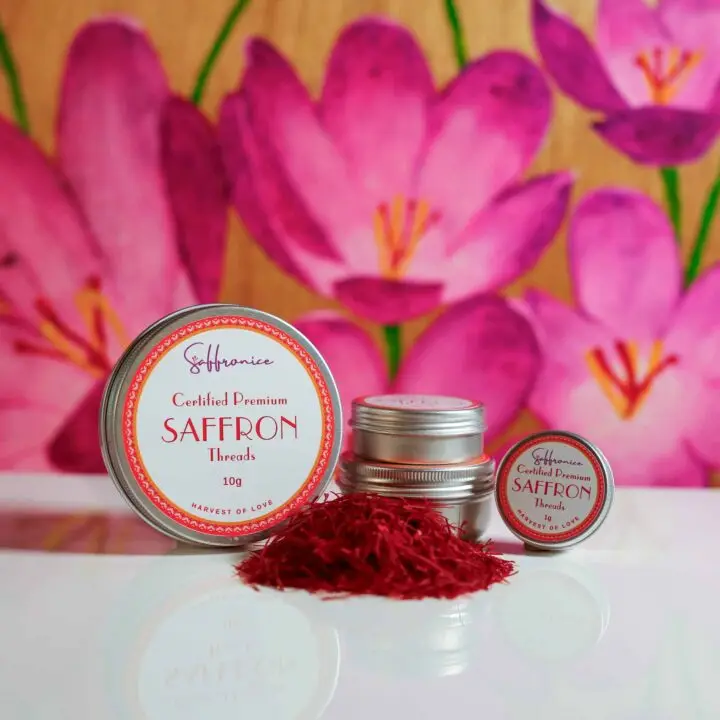📌 Quick Answer: Saffron’s history spans over 4,000 years, originating from wild Crocus cartwrightianus in Greece and ancient Persia. Archaeological evidence from 1600-1500 BC shows its cultivation by the Minoans. The spice traveled through trade routes to India, Europe, and beyond, becoming central to Persian, Mediterranean, and Middle Eastern cultures for cooking, medicine, and religious ceremonies.
Have you ever wondered why saffron commands such reverence across cultures? Understanding what saffron is reveals a spice steeped in history, treasured for over 4,000 years across civilizations from ancient Persia to modern kitchens worldwide. This precious commodity has been utilized in everything from medicine to artistic expression, with each Crocus sativus plant producing just one flower, requiring approximately 150,000 flowers for a single kilogram of saffron.
This extraordinary fact underscores saffron’s rarity and explains its designation as “red gold.” As we explore this comprehensive journey, we’ll uncover how saffron evolved from a wild flower into the world’s most expensive spice, shaping culinary traditions, medical practices, and cultural ceremonies across continents.
Historical Significance: Archaeological evidence demonstrates saffron’s central role in ancient civilizations, from Minoan religious ceremonies to Persian royal banquets, establishing it as both a luxury commodity and an essential cultural element throughout human history.

Ancient Origins and Botanical Evolution
The Wild Precursor: Crocus cartwrightianus
The story of saffron cultivation begins over 4,000 years ago with the wild Crocus cartwrightianus, primarily found in Greece. Early cultivators recognized this plant’s exceptional characteristics, particularly its elongated stigmas that would become the foundation of saffron production.
Through careful selection and cultivation, ancient farmers developed what we now know as Crocus sativus, a sterile triploid that reproduces exclusively through human intervention. This botanical evolution represents one of humanity’s earliest examples of deliberate plant breeding for specific desired traits.
Geographic Distribution and Early Cultivation:
- Primary Origins: Greece and Asia Minor (modern-day Turkey)
- Early Expansion: Ancient Persia by the 10th century BC
- Trade Route Development: India and China by 100 BC
- Mediterranean Spread: Throughout the Greek islands and mainland by 800 BC
Archaeological Evidence and Documentation
Archaeological discoveries provide compelling evidence of saffron’s ancient importance. The most significant findings include:
Minoan Civilization (1600-1500 BC): The famous Akrotiri frescoes on Santorini depict women gathering saffron crocuses, representing the earliest known artistic documentation of saffron harvesting. These frescoes demonstrate not only the practice of cultivation but also the ceremonial and religious significance attributed to saffron in Minoan society.
Ancient Mesopotamian Texts: Cuneiform tablets from Assyrian and Babylonian periods (1000-500 BC) reference saffron in medical prescriptions and royal correspondence, indicating both therapeutic applications and its status as a luxury commodity worthy of royal attention.
Persian Empire and Cultural Foundation
Royal Patronage and Cultivation Mandates
Ancient Persia established the foundation for saffron’s global significance. King Darius I (522-486 BC) reportedly mandated saffron cultivation throughout the Persian Empire, recognizing both its economic value and cultural importance. Saffron’s ancient medicine applications were extensively documented in Persian medical texts.
Persian Administrative Records:
- Royal Gardens: Saffron cultivation in royal gardens at Persepolis
- Tribute Systems: Saffron as tribute from various provinces
- Medical Corps: Persian army physicians using saffron for wound treatment
- Religious Ceremonies: Zoroastrian rituals incorporating saffron offerings
Cultural Integration and Culinary Development
Persian saffron cuisine developed sophisticated applications that continue to influence modern cooking. Ancient Persian cooks created elaborate preparations that showcased saffron’s unique properties:
Traditional Persian Applications:
- Ceremonial Rice Dishes: Elaborate preparations for religious festivals
- Royal Banquets: Multi-course meals featuring saffron in each dish
- Medicinal Preparations: Therapeutic teas and tonics
- Religious Offerings: Sacred preparations for temple ceremonies
The Persians developed techniques for maximizing saffron’s flavor and color, including the practice of soaking threads in warm liquids before incorporation into dishes, a method still used today.
Greek Civilization and Mediterranean Expansion
Minoan Religious and Cultural Practices
The Minoan civilization (3000-1100 BC) represents the earliest documented large-scale use of saffron in European culture. Archaeological evidence from Knossos and Akrotiri reveals a sophisticated understanding of saffron’s cultivation and processing.
Minoan Saffron Applications:
- Religious Ceremonies: Sacred offerings to goddesses
- Textile Dyeing: Luxury fabrics for religious and royal use
- Medicinal Practices: Early Pharmaceutical Applications
- Artistic Expression: Pigment for frescoes and decorative arts
Classical Greek Period and Mythological Significance
Ancient Greek literature and mythology extensively feature saffron, indicating its deep cultural integration. The myth of Crocus, transformed into the saffron flower after a tragic love affair, illustrates how Greeks attributed divine significance to this spice.
Greek Historical Documentation:
- Homer’s Iliad: References to saffron-robed Dawn
- Medical Texts: Hippocratic corpus describing therapeutic uses
- Trade Records: Commercial transactions involving saffron
- Religious Practices: Offerings at Delphic Oracle
Roman Empire and Culinary Sophistication
Luxury Consumption and Social Status
The Roman Empire elevated saffron consumption to unprecedented levels of sophistication and excess. Wealthy Romans used saffron not only in cooking but also for personal luxury, including saffron-scented baths and perfumes.
Roman Saffron Extravagance:
- Imperial Banquets: Emperor Heliogabalus reportedly bathed in saffron
- Culinary Innovation: Complex sauces and delicate preparations
- Medical Applications: Documented treatments for various ailments
- Social Distinction: Marker of wealth and sophistication
Economic Impact and Trade Networks
Roman demand for saffron established extensive trade networks reaching across the known world. Roman merchants developed standardized quality measures and pricing structures that influenced saffron commerce for centuries.
Roman Trade Statistics:
- Import Routes: Primary sources from Cilicia and Kashmir
- Quality Standards: Grade classifications are still used today
- Price Documentation: Cost equivalent to its weight in gold
- Distribution Networks: Throughout Roman territories and beyond
Medieval Period and Trade Route Expansion
Islamic Golden Age and Scientific Documentation
The Islamic Golden Age (8th-13th centuries) marked significant advances in saffron cultivation and medical applications. Islamic scholars preserved and expanded upon classical knowledge while developing new therapeutic applications.
Islamic Contributions:
- Agricultural Texts: Detailed cultivation manuals
- Medical Treatises: Systematic study of therapeutic properties
- Trade Expansion: Introduction to North Africa and Iberia
- Quality Standardization: Development of grading systems
The Spice Trade and Economic Significance
Medieval trade routes established saffron as one of the world’s most valuable commodities. The spice’s lightweight nature and extraordinary value made it ideal for long-distance trade.
Medieval Trade Networks:
- Silk Road: Overland routes connecting East and West
- Maritime Routes: Venetian and Genoese trading networks
- Commercial Centers: Constantinople, Venice, and Cordoba
- Banking Systems: Letters of credit for saffron transactions
European Integration and Cultural Adaptation
Moorish Influence in Iberia
The Moorish conquest of Iberia (711-1492 AD) introduced sophisticated saffron cultivation techniques to Spain. The combination of Islamic agricultural knowledge and a suitable Mediterranean climate created ideal conditions for saffron production.
Iberian Development:
- La Mancha Region: Establishment as a premier growing area
- Cultural Fusion: Blend of Islamic and Christian culinary traditions
- Export Networks: Distribution throughout European markets
- Quality Recognition: Spanish saffron achieves premium status
French and Italian Culinary Integration
Medieval French and Italian cuisines gradually incorporated saffron into their culinary traditions, creating distinctive regional applications that persist today.
European Culinary Evolution:
- French Cuisine: Integration into sophisticated sauces and preparations
- Italian Regional Dishes: Development of risotto and regional specialties
- Monastic Cultivation: Monastery gardens preserving cultivation knowledge
- Noble Courts: Royal kitchens showcasing saffron’s luxury status
Asian Expansion and Cultural Significance
Indian Subcontinent and Kashmiri Cultivation
Saffron reached the Indian subcontinent around 100 BC, with Kashmir developing into one of the world’s premier growing regions. The unique climate and soil conditions of Kashmir proved exceptionally suitable for saffron cultivation.
Indian Historical Development:
- Mughal Period: Imperial patronage of saffron cultivation
- Regional Specialization: Kashmir is becoming synonymous with quality
- Culinary Integration: Saffron rice dishes in royal cuisine
- Trade Networks: Distribution throughout Asia
Chinese Integration and Medicinal Applications
Chinese adoption of saffron occurred gradually through trade contacts, with particular emphasis on medicinal applications documented in traditional Chinese medicine texts.
Chinese Historical Usage:
- Medical Texts: Documentation in pharmacological treatises
- Trade Records: Imperial court purchase records
- Cultural Adaptation: Integration into traditional medicine systems
- Regional Cultivation: Limited experimental growing in suitable climates
Modern Era and Global Distribution
Colonial Period and New World Introduction
European colonization attempts to establish saffron cultivation in the Americas met with limited success, though some regions showed promise for small-scale production.
Colonial Cultivation Attempts:
- Pennsylvania Dutch: Successful small-scale cultivation
- Spanish Colonies: Limited success in similar climates
- Trade Monopolies: European control of major production
- Economic Factors: High labor costs are limiting expansion
Contemporary Global Production
Modern saffron production remains concentrated in traditional growing regions, with Iran producing approximately 85% of the world’s supply. Sustainable saffron farming practices are becoming increasingly important for maintaining production quality and quantity.
Current Production Statistics:
- Iran: 85% of global production (approximately 300 tons annually)
- India (Kashmir): 5% of global production
- Spain: 3% of global production (highest quality designation)
- Other Regions: Greece, Morocco, Afghanistan (combined 7%)
Cultural and Artistic Significance
Artistic Representations Through History
Saffron has inspired artistic expression across cultures and centuries, from ancient frescoes to contemporary works. Its distinctive color and cultural significance made it a symbol of luxury, divinity, and transformation.
Artistic Documentation:
- Ancient Frescoes: Minoan and Egyptian wall paintings
- Medieval Manuscripts: Illuminated texts featuring saffron imagery
- Religious Art: Christian and Islamic artistic traditions
- Contemporary Works: Modern artistic interpretations
Modern Cultural Celebrations
Contemporary saffron-producing regions maintain traditional festivals celebrating harvest seasons and cultural heritage. These celebrations preserve ancient customs while adapting to modern contexts.
Festival Traditions:
- Iranian Harvest Festivals: Community celebrations in growing regions
- Spanish Saffron Festivals: La Mancha regional celebrations
- Kashmir Cultural Events: Traditional harvest ceremonies
- Greek Island Festivals: Continuation of ancient traditions
Economic Evolution and Modern Challenges
Historical Economic Impact
Throughout history, saffron has maintained its position as one of the world’s most valuable spices by weight. Saffron market trends show consistent demand despite price fluctuations.
Economic Milestones:
- Ancient Period: Value equivalent to gold weight
- Medieval Period: Basis for international trade agreements
- Modern Era: Prices ranging from $1,100-$11,000 per kilogram
- Contemporary Market: Global trade valued at $300+ million annually
Contemporary Production Challenges
Modern saffron cultivation faces numerous challenges that threaten traditional production methods and quality standards.
Current Challenges:
- Climate Change: Altered precipitation patterns affecting yields
- Labor Costs: Increasing expenses for hand-harvesting
- Quality Control: Maintaining standards amid market pressures
- Competition: Synthetic alternatives and adulteration issues
Health Benefits and Modern Applications
Traditional Medicine Legacy
Saffron’s health benefits, documented throughout history, continue to be validated by modern research. Ancient therapeutic applications are finding support in contemporary scientific studies.
Historical Therapeutic Uses:
- Persian Medicine: Digestive and mood disorders
- Greek Medicine: Respiratory and cardiovascular conditions
- Islamic Medicine: Comprehensive therapeutic applications
- Traditional Chinese Medicine: Circulatory and emotional disorders
Contemporary Scientific Validation
Modern research confirms many traditional applications while discovering new potential benefits. Saffron antioxidants and other bioactive compounds demonstrate significant therapeutic potential.
Modern Research Validation:
- Antioxidant Properties: Clinical studies confirming cellular protection
- Mood Enhancement: Depression and anxiety reduction in controlled trials
- Cognitive Support: Memory and learning improvement studies
- Anti-inflammatory Effects: Reduction of inflammatory markers

Contemporary Culinary Applications
Global Cuisine Integration
Modern chefs worldwide continue expanding saffron’s culinary applications while respecting traditional methods. How to cook with saffron technique combines historical knowledge with contemporary innovation.
Contemporary Applications:
- Molecular Gastronomy: Modern techniques for extracting maximum flavor
- Fusion Cuisine: Combining traditional applications with new flavors
- Health-Conscious Cooking: Emphasizing nutritional benefits
- Artisanal Products: Craft foods highlighting saffron’s unique properties
Beverage Applications
Traditional saffron beverages continue evolving with modern preferences. Saffron tea benefits appeal to health-conscious consumers seeking natural wellness solutions.
Modern Beverage Trends:
- Wellness Teas: Therapeutic blends for specific health goals
- Craft Cocktails: Premium cocktails featuring saffron complexity
- Functional Beverages: Health drinks incorporating saffron extracts
- Traditional Preparations: Maintained cultural beverage traditions
Future Outlook and Preservation
Sustainable Cultivation Practices
Maintaining saffron production for future generations requires addressing current challenges through sustainable practices and technological innovation.
Sustainability Initiatives:
- Water Conservation: Efficient irrigation systems for arid regions
- Organic Certification: Chemical-free cultivation methods
- Fair Trade Practices: Ensuring farmer economic sustainability
- Climate Adaptation: Varieties resistant to changing conditions
Cultural Heritage Preservation
Protecting saffron’s cultural significance involves preserving traditional knowledge while adapting to modern realities.
Preservation Efforts:
- UNESCO Recognition: Cultural heritage designation initiatives
- Traditional Knowledge Documentation: Recording cultivation techniques
- Festival Maintenance: Continuing cultural celebrations
- Educational Programs: Teaching younger generations traditional methods
Conclusion: Saffron’s Enduring Legacy
Saffron’s remarkable 4,000-year journey from wild Greek hillsides to global kitchens demonstrates humanity’s enduring relationship with this extraordinary spice. Archaeological evidence from Minoan frescoes to Persian royal records illustrates saffron’s consistent cultural significance across civilizations.
Historical Impact Summary:
- Cultural Foundation: Central role in ancient religious and social practices
- Economic Influence: Establishment of international trade networks
- Culinary Evolution: Development of sophisticated cooking traditions
- Medical Contributions: Therapeutic applications validated by modern science
- Artistic Inspiration: Continuous influence on artistic expression
Contemporary Significance: Today’s saffron industry faces challenges from climate change and economic pressures while maintaining quality standards established over millennia. The spice’s journey from ancient luxury to modern necessity reflects humanity’s evolving relationship with natural products that provide both pleasure and health benefits.
Future Considerations: Preserving saffron’s legacy requires balancing traditional cultivation methods with sustainable practices, ensuring this golden treasure continues to enrich cultures worldwide. As we face modern challenges, saffron’s history provides valuable lessons about patience, quality, and the enduring value of traditional knowledge.
The story of saffron continues evolving, with each harvest connecting contemporary practitioners to thousands of years of human cultivation, trade, and cultural exchange. From ancient Persian kings to modern home cooks, saffron remains a bridge between past and present, tradition and innovation.
FAQs (Frequently Asked Questions)
Where did saffron originally come from, and how old is its cultivation?
Saffron originated from the wild Crocus cartwrightianus in Greece over 4,000 years ago. Archaeological evidence from Akrotiri shows Minoan cultivation around 1600-1500 BC, while ancient Persian records document systematic cultivation under King Darius I around 500 BC.
How did saffron spread across different continents and cultures?
Saffron spread through ancient trade routes: from Persia to India and China (100 BC), to Europe via Moorish influence in Spain (8th century), and through Mediterranean trade networks. Each culture adapted saffron to local culinary and medicinal traditions while maintaining its luxury status.
Why has saffron been so valuable throughout history?
Saffron’s value stems from extreme labor intensity (150,000 flowers per kilogram), limited growing regions with specific climate requirements, and multiple applications in cooking, medicine, dyeing, and religious ceremonies. Its rarity and versatility maintained premium pricing equivalent to gold throughout history.
What role did saffron play in ancient religious and cultural practices?
Ancient cultures used saffron in religious offerings, royal ceremonies, and artistic expression. Minoans featured it in religious frescoes, Persians used it in Zoroastrian rituals, Greeks incorporated it into mythology, and Romans employed it for luxury and status demonstration.
How do modern cultivation methods compare to ancient techniques?
While core hand-harvesting methods remain unchanged due to saffron’s delicate nature, modern cultivation incorporates improved irrigation, organic practices, and climate adaptation strategies. Traditional knowledge about timing, drying, and quality assessment continues to guide contemporary production.
What challenges does saffron cultivation face in the modern era?
Contemporary challenges include climate change affecting traditional growing regions, rising labor costs, quality control amid market pressure, synthetic competition, and the need for sustainable practices to preserve both environmental and cultural heritage for future generations.



